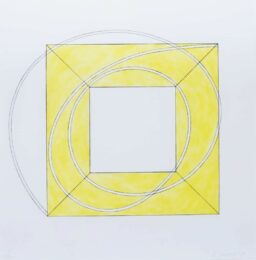

New York artist Robert Mangold is a key figure in contemporary minimalism. His work derives from a minimalist vocabulary, featuring architectural shapes such as rings, columns, crosses and trapezoids. He graduated with a BFA and MFA from Yale University, after transferring from his initial education at the Cleveland Institute of Art in Ohio, 1956-1959. Mangold primarily practises with acrylic and pencil media on canvas, adopting a monochromatic colour scheme. He experiments with the overlapping of shapes. The minimalist movement began in 1950’s New York, exploring the reflection of time and place. It extends the notion that art can exist independently of the artist’s personal expression. It portrays the nature of the work itself, rather than attempting to reflect the real world.
Alongside Robert Mangold, major American artists such as Stella and Judd have contributed to the minimalist movement. Frank Stella explores abstract pattern and colour through painting, sculpture, and print. Donald Judd’s work sought to depict the space created by an object. Through differing styles, Mangold, Stella and Judd have practised the subtle and contemplative ways of seeing shapes. Mangold’s work has been exhibited worldwide in galleries such as the Biennale in Venice, 1993, the Guggenheim in New York, 1971, and the Stedelijk, Amsterdam in 1997. Mangold continues to practise in Washingtonville, New York.